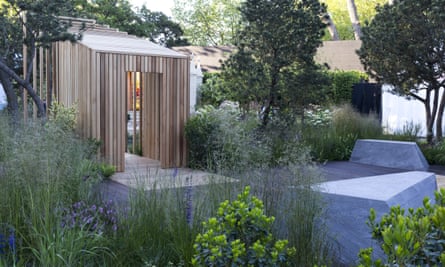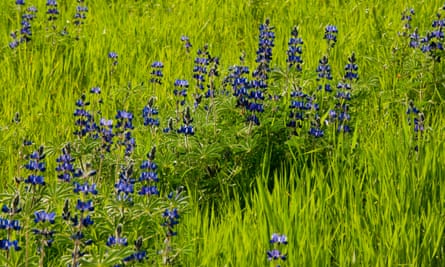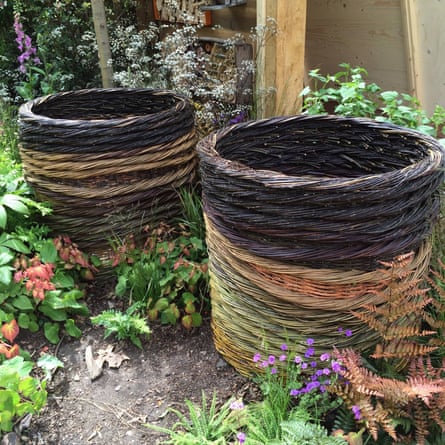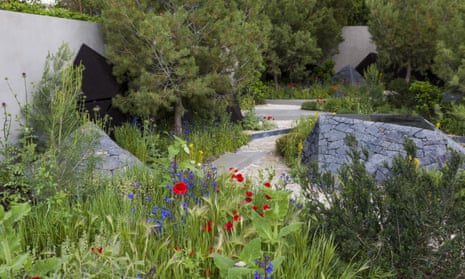1 Finally, we’re over cow parsley
The meadow planting that has been so prevalent in recent years has moved in two different and competing directions. In one clutch of show gardens, the naturalism (in Chelsea parlance, a borrowed or captured landscape) of all those frothy plants has morphed into another type of landscape: the dry garden. We’re talking scree, gravel, drought-resistant plants: this year, Hugo Bugg’s Royal Bank Of Canada garden and Andy Sturgeon’s Telegraph garden were the standouts. But elsewhere, the froth of the meadow had an injection of riotous colour and an exuberant “everything plus the kitchen sink” approach to planting. Ann-Marie Powell’s RHS Greening Grey Britain garden epitomised the trend, with its bright orange shipping container of an outdoor room, echoing the bright orange geums among purple alliums; see also Diarmuid Gavin’s riotous planting in his Harrods British Eccentrics garden.
2 Pines replace topiary

The Guardian’s product and service reviews are independent and are in no way influenced by any advertiser or commercial initiative. We will earn a commission from the retailer if you buy something through an affiliate link. Learn more.
Tightly clipped topiary, in boxes, balls or hedges, was once everywhere at Chelsea, but not this year (apart from Gavin’s garden, where it was taken up to – and possibly beyond – the limit, with an avenue of conical clipped bay trees that twirl on the spot every few minutes). What took its place? Native trees, particularly pines, in a more relaxed style. My favourites were the dense, grey-green of the glaucous Scots pine (Pinus sylvestris ‘Glauca’) in Nick Bailey’s Winton’s Beauty Of Mathematics garden, and Sam Ovens’ looser, less controlled dwarf mountain pine (Pinus mugo) in the Cloudy Bay garden (right down to a broken branch on the ground; Ovens had to keep stopping people from tidying it away).
3 Small is beautiful

The smallest gardens at Chelsea (the artisan gardens) are often the most desirable for the average punter. The garden I’d like to take home this year is the Senri-Sentei garage garden, created by Japanese designer Kazuyuki Ishihara. It’s cute, compact and beautiful, with a haze of colourful Japanese acers festooning the rooftop garden that shelters a vintage Mini.
4 Lawns rule

To anyone unacquainted with the mores of Chelsea, the idea that a lawn might be controversial must seem very odd: after all, it’s a central feature of most British plots. But Jo Thompson’s Chelsea Barracks garden, billed as a rose garden reimagined for the 21st century, contains a sizable green sward rarely seen at the show these days.
5 Stone walls

If there’s a theme to the hard landscaping this year, it’s rough-hewn stone: it came in boulders and as drystone walls in Cleve West’s M&G garden; as gabion walls in Rosy Hardy’s Brewin Dolphin Forever Freefolk garden, and drystone walls in the Provence landscape of James Basson’s L’Occitane garden. As a trend, it’s an unusually accessible one. Get yourself on a drystone wall course this summer and you could have built your own by Christmas.
6 The medium is the message

Garden sponsorship makes for odd bedfellows: while some designers are bankrolled by investment funds, others are sponsored by charities with a serious message. Can a garden make people think a little harder about Ebola or meningitis? I don’t know, but with 165,000 visitors passing through the showground last week and millions more watching on TV around the world, you can see why they try. The Modern Slavery garden by Chelsea first-timer Juliet Sargeant is notable for its powerful message; at the centre of the garden is an English oak, symbolising the tree where William Wilberforce stood when he dedicated his life to ending slavery.
7 It’s a fair copper

The interior decorating trend for coppery tones has been picked up in both planting and objects: see the wonderful copper water bowl by sculptor Giles Rayner in Nick Bailey’s garden, the orange isoplexis in Andy Sturgeon’s garden.
8 Lupin love

Every year, there are a few plants in the show gardens that everyone wants to grow immediately. For me, it was the gorgeous, navy-blue lupins (Lupinus pilosus) in Bugg’s garden. Not only are its blooms stunning, the plant is drought-tolerant and a nitrogen fixer.
9 Spotty Dotty

Away from the glare and glamour of the show gardens, the pavilion is simply all about the plants. Of all the delights of its nursery exhibits, one plant calls out to me every year: Podophyllum ‘Spotty Dotty’, with mottled umbrella-like leaves and wine-red flowers. Perhaps it’s finally the year to give it a go.
10 Bins can be beautiful, too

Even composting has a place at Chelsea. If there was one thing I wanted to steal from this year’s show, it was Powell’s wonderful cylindrical woven willow compost bins made by Staffordshire basketmaker Eddie Glew. With these beauties, you wouldn’t want to hide your composting in a corner.

Comments (…)
Sign in or create your Guardian account to join the discussion